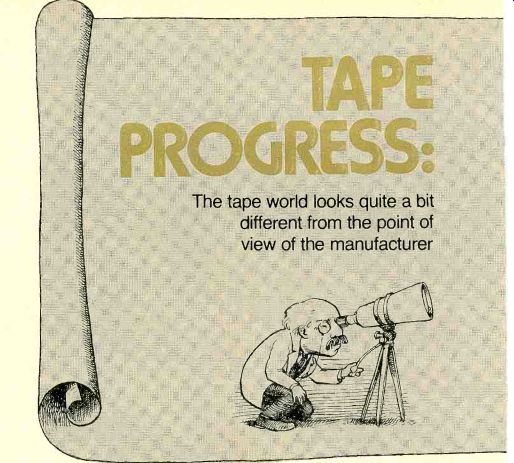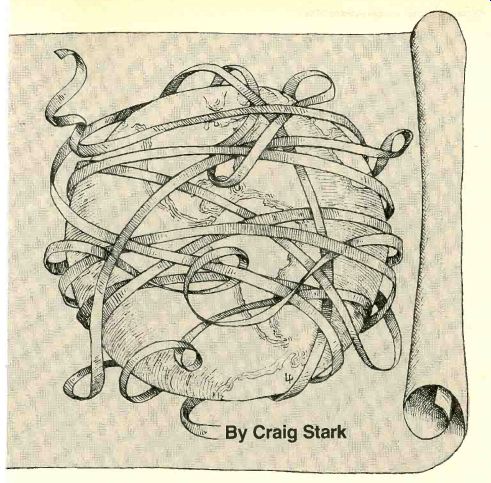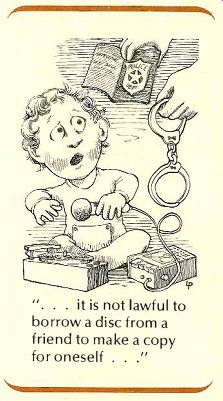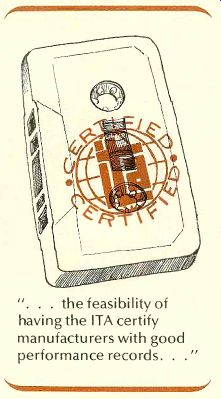

TAPE PROGRESS--The tape world looks
a bit different from the manufacturer's point of view.
by Craig Stark
THE audio trade shows most of us are familiar with deal mainly with upcoming consumer and professional audio products or with the technical developments behind them.
Recently, however, I had the opportunity to attend a very different type of industry get-together: the Sixth Annual Seminar of the International Tape Association in Tucson, Arizona. The ITA is a forum that brings together many of the top executives of companies en gaged in the magnetic-tape industry worldwide. They meet to pool their knowledge and experience on every thing from graphic design for cassette packaging through video-tape manufacture and uses in industry and education, to global economic and political forecasts of trends and events that will affect the tape business. In addition, this influential organization (it has grown in a few short years to include over two hundred corporate members) has assumed a major role in the industry's self-regulatory effort by handling consumer problems, setting and updating standards, and policing question able practices. (The ITA has its national office in New York City.) Getting a chance to see the industry as a whole did occasion a shift--or rather expansion--in my perspective of the tape world. When you and I think about tapes or machines, we are typically concerned about some practical performance question. And when some significant technical advance is made, we wonder why everyone doesn't rush right in to emulate it. From the businessman's point of view, however, the situation is rather different. The dedicated tape enthusiast who worries about differences among premium tapes, for example, represents an almost negligible percentage of the market, meaning that the lion's share of the profits is being made elsewhere. Take, as one small example, the matter of the improved ferric oxides that take advantage of the CrO2 switch position on cassette machines: the great majority of the "machine population," according to the consensus of those to whom I spoke, consists of under-$100 units that don't even have a "normal-chrome" switch! As an example of just what is involved over in the "lion's share" area, Terry Wherlock of Intermagnetics Corp. described his company's world wide ventures, particularly in the Asian countries. Though his company is aiming for an annual production of 200 mil lion (!) cassettes by 1980, he estimated that a typical small factory, with a capacity of perhaps 6 to 10 million cassettes annually, would involve a capital investment of about $250,000 (a larger plant, capacity 25 to 30 million annually, would cost between $450,000 and $750,000).
Better Tape
The subject of the audiophile's persistent quest for better tapes was not ignored, however. David Monoson, consultant to Maxell, described the coating techniques used by the firm in its high-quality tapes. It all starts with a multi-stage pre-mixing process (aided by ultrasonic agitation) in which all the solvents, resins, and other chemicals are completely blended before the actual oxide particles are added. In this way, the oxide needles themselves spend less time being ground around within a ball mill before the coating is applied, so fewer of them become crushed and broken. It is these smashed, very much undersized particles whose unstable magnetic characteristics are prime contributors to hiss and print-through, and the new technique is claimed to reduce their incidence by half. Alan Lindquist of Pfizer (which, together with Hercules Powder, makes much of the "raw" ferric oxide used in tape throughout the world) expressed some doubt that particle breakage in ordinary milling was quite as significant a problem as Monoson implied, but, of course, any reduction in the number of crushed oxide needles represents an improvement when quality is the goal.
At each stage of the process, from depositing the wet "slurry" (the liquid binder materials plus the oxide particles, each of which must be completely coated by the binder) onto the base film, through the drying stage (where microwave energy can be used in addition to infra-red heating), to the final surface polishing or "calendaring," a number of highly sophisticated techniques are involved in making top-grade tape. One, still in the experimental stage, particularly caught my inter est. It has long been known that you can improve the signal-to-noise ratio of a tape by approximately 6 dB if, while the oxide particles are still wet and free to move about in the binder, you line them all up in the same direction by passing the tape through a powerful unidirectional magnetic field. (For audio purposes, the needles are aligned lengthwise along the tape; for quadraplex [broadcast] video application, they are set perpendicular to the tape edge). Unfortunately, however, not all the particles do line up while under the influence of the magnetic field, so the full benefit of the technique is never realized. But, according to Monoson, experimental results have shown that if, during the alignment process, the wet tape is simultaneously subjected to ultrasonic agitation, the percentage of particles achieving proper orientation increases, giving a net improvement of between 1 and 2 dB in signal-to-noise ratio. That's hardly worth the bother for mass-market tapes, but it would mean just that much more music to the ears of audiophiles. Memorex's Bob Murashige expressed it best at break fast one morning when he said, "You know, you hear some of these guys saying that the hi-fi market is maybe only five percent of the machine population. But the whole thrust, the thing that's made the cassette market what it is today, has been the effort to be as good as open-reel."
Tape in Education
Still, the principal focus of attention in the working sessions was on non hi-fi applications for tape, particularly in industry and education. Executive and employee training and motivational programs using tape (sometimes cassettes with workbooks or slides, some times video tapes) seem to be blooming like flowers in spring, requiring the sup port services not merely of tape duplicators, but of companies that pre pare the programs, companies that package them, and even companies that make splicing-tape dispensers to attach your tape to the short leaders that come with CM (empty, that is) cassette housings.
One man, who said he represented "the Christian market" (gospel music and sermons, one would imagine) inquired about packaging methods that would draw customers' attention to displays of his cassettes which, he said, tended to be impulse purchases. I couldn't help smiling when, in recommending the vacuum-formed blister-pack technique, his answerer laid heavy emphasis on the fact that this form of display was the most pilfer-proof. A representative of the U.S. Selective Service told how, with a staff of only twenty-one people (and automat ed equipment) they have been able to produce a million slides and fifty thousand cassettes a year to help keep four thousand local boards up to date on interpreting the draft law.
Harry McGee, Executive Vice President of the National Audio-Visual Association, told of uses for tape all the way from alerting people to the danger of fire in the upper stories of high-rise buildings to a grocery chain that employed a continuously running audio visual program to persuade customers of the special merits of grass-fed beef. Educators abounded, from Dr. Donald Hess, whose Granite School District (Salt Lake City, Utah) utilizes more than six hundred video player/recorders and fifty thousand video cassettes, to Dean Walter J. Fahey of the University of Arizona, whose Micro-campus produces video tapes of college courses you can take for credit, with ti tles as diverse as Women and the Novel and Electrical Engineering.
Speech Compression
With so much emphasis on information transfer and the spoken word, it is not surprising that the hottest topics at the ITA Workshop on "New Concepts and Technology" were speech compression and the microcassette, both of which may be somewhat new to STEREO REVIEW readers, but will not remain so for long. The type of "compression" we're most familiar with is amplitude compression, in which the loudness difference between a whisper and a shout is reduced. This is what gives the voices on TV commercials their peculiar force and punchiness (pushiness?), even though they seem to be delivered at normal conversational levels. But the kind of compression co-moderators Ed Hanson (North American Philips) and George Saddler ( Fuji) had under discussion was time compression-something able to employ on the twenty hours of tapes I brought back with me from Tucson! With this technique, ordinary speech can be speeded up (it can also be slowed down if you like) as much as the listener wants, and without any change in pitch--the "Mickey Mouse" effect that normally results from playing a tape at a higher speed than that at which it was recorded.
It has long been known that the nor mal person can read many times as fast as he talks, so the brain is obviously capable of processing information much more rapidly than the ear normally receives it. It would therefore be a boon to many-the blind perhaps most of all, though the interest potential is clearly broader--if speech could be speeded up without sacrificing its intelligibility.
The first attempts to produce speed ed-up speech used the clearly impractical method of physically editing out excessive pauses between words and syllables with a razor blade (history does not record whether the person who first undertook the task suffered early retirement to a rest home). In re cent years it has become technologically possible to chop out selected bits of speech sound and join the severed portions together electronically, but it required an entire relay rack of expensive equipment to do so.
Now, however, the entire task of slicing speech into tiny time intervals, throwing about half of them away and rejoining the rest, plus controlling the playback speed of a recorder, can be built into two or three integrated circuits containing an "analog shift register" (more commonly called a "bucket brigade," the same sort of device used in several audiophile room-reverberation units). All this can be fitted into just about any recorder while adding only $50 or $70 to its cost.
A panelist brought such a modified machine to the Tucson sessions; we all used it, so I know it works. Research conducted by the University of Louisville indicates, further, that information retention using the speeded-up speech is actually better than when we listen at a normal speed, presumably because we find it easier to concentrate on the material. Within five minutes all of us at the table could work very com fortably at two or two and a half times normal speed, so, where information must be gained through the spoken word, this new application of contemporary technology offers a tremendous time saving.
Microcassettes
The whole history of tape after the Second World War has been one of finding ways to put more and more in formation on less and less tape. Daniel E. Denham of 3M noted in a luncheon address that not so long ago it took 4.5 square yards of material to record what, in cassette form, now requires only 0.6 yard. So, anyone for a half speed cassette about the size of a small matchbox? In a word-or, perhaps, two-that's the "microcassette" or "minicassette." Though the two are similar in appearance, the Philips entry (the "mini") is-truly, this time! intended as a dictation device. It is hub-driven, so the actual tape speed (and hence frequency response and dynamic range) depends on the relative amounts of tape on the two "reels." The Panasonic and Olympus "micro," on the other hand, is capstan driven at 15/16 ips and is, according to some pundits, already as good as regular cassettes were only a few years ago. There are those who are convinced that the microcassette will eventually drive out its "big" brother, just as cassettes themselves have supplanted open reel for all but the most critical applications. Think of it--a year's worth of music in glove compartment!
Tape and the Law
At another of the round-table seminars, attorneys Ernest Meyers, Jules Yarnell, and Sidney Diamond, along with Thomas Valentino (whose firm supplies music and sound effects for TV commercials, industrial training programs, and the like) presented a very thorough discussion of current copyright law. At present we are operating under an amendment (effective February 15, 1972) to the 1911 act, al though a new, comprehensive copyright law (S. 22) has finally ground its way through the legislative process and will take effect after January 1, 1978.

". . . it is not lawful to borrow a disc from a friend to make a copy for oneself . . ."
As these gentlemen were the first to confess, even the new law, which was intended to simplify matters, has a text the size of a small telephone directory--and is far harder to read.
From the perspective of the audiophile, whether under the old or the new law, several things are very clear-but the rest is so muddy that one needs an attorney to make sense of it. In the first place, the home recordist does have the legal right to make tape copies of broadcasts, and of records and tapes which he owns, for his personal and private use, assuming he has no intention of capitalizing commercially on them.
This "home use" provision was writ ten into the law, according to Mr. Yarnell, so that senators and congressmen wouldn't find themselves in the position of making their own children criminals for making cassette or eight-track copies of their own record collections (that's a joke, son). Secondly, how ever, it is equally clear that it is not lawful to borrow a disc from a friend to make a copy for oneself, or to make a copy of one's own disc for a friend.
Obviously, as a practical matter, no one is likely to bring an action against you for an occasional minor infringement of this latter kind, but it is against the law. And, where the practice be comes flagrant, as has been the case where college students have each bought a record or tape, made several dozen copies of it, and then organized a swap session, warning letters have in fact gone out and schools have put a stop to the practice where they could.
In cases where the master tape of the work copied antedates February 15, 1972, the offense is not technically an infringement of copyright but is known as "piracy," against which almost all states now have specific statutes. As Meyers put it, piracy "would violate ... the common law of all states where the courts have considered the question."
Further, whatever the date of the material, "home use" provisions do not permit a dentist, for example, to dub background music that he will later play in his office, for that brings the matter into the field of commercial use.
Dentists, restaurateurs, and even elevators are therefore advised to deal with a music service which has obtained all rights to the recorded entertainment it purveys.
Even if you buy a record or tape, you are not free to make a commercial application of it. And if, like me, your chief recording interest lies in capturing the sound of the live performance, be sure you obtain authorization to do so, or you will be guilty of "bootlegging," which, as Meyers pointed out, "may violate state laws designed to protect artists against the misappropriation of their performances, as well as constituting an infringement of the underlying copyrighted musical work."
Prerecorded Tape
At still another round table, quality control was the focus of attention. Audio Digest has made available a cassette subscription service for the medical profession which enables doctors to use odd moments (such as time spent driving to work) to keep up with developments within their field. Having a limited market potential has made it extremely important to ensure customer satisfaction, and Audio Digest's extraordinarily low return rate (0.2 percent) was the envy of everyone who sat in on the discussion. The secret, un happily, seems to involve not only extreme care in selecting commercial duplicators who can be relied on to keep their equipment in good condition, but in requiring them to use specific brands of tape and/or specific brands of C-0 cassette housings. Audio Digest discovered their workable combinations purely on the basis of experience, and it appeared from the discussion that their approach increases costs for the raw cassette from about a half dollar to perhaps twice that. Most of the premium tapes you and I buy are not even affordable by the typical supplier of prerecorded tapes, given the tight profit margins he must work within.
I raised the point that the complaints I get from readers aren't usually that their prerecorded cassettes jam, or have tracks recorded on them back ward, or the like; freedom from this kind of gross defect is taken for grant ed. My complaints center on the fact that the frequency response, distortion, and signal-to-noise ratio on prerecorded tapes-both open reel and cassette-simply don't match those of the equivalent disc, yet the customer is expected to pay a premium for tape. Buyers very quickly become aware that they can usually make a better dub from a new disc themselves than the one they can buy in a store. Is the high speed duplication process inherently incapable of making hi-fi copies? Various answers issued from various quarters, but in the final analysis they all boiled down to the question of cost.
Paul Lloyd of Infonics (maker of a medium-speed duplicator that operates at 10.7 times playing speed) pointed out that his equipment left the factory flat to 14,000 Hz, was 3 dB down at 15,000 Hz, rolled off sharply thereafter, and added no more than 3 dB of hiss to that already on the master tape. But when the equipment got into the hands of the duplicating company, all kinds of problems could develop if it was not maintained and operated properly. In his view, keeping frequency response out to 15,000 Hz was imperative, though it might require running the copies at a slightly lower signal level (meaning a couple decibels of loss in signal-to noise ratio) than is customary. "The long-haired kids you kicked out of your stores fifteen years ago are now the heads of curricula at the colleges or they're disc jocks; in either case they insist on that high end and they'll listen to the music through the hiss." Bill Lawless, whose Recortec duplicators operate at the more custom ary thirty-two times playing speed, was willing to settle for a top end of 12,000 Hz (arguing that only a tiny handful of consumer playback machines were flat to 15,000 Hz). In his view, hiss is the primary problem. Good high-speed duplicators (not only his own company's) are capable of adding no more than 2 or 3 dB of noise to the master tape-a figure all of us would gladly settle for.
But why, then, isn't that what we get? It goes back to carelessness on the part of the duplicator in adjusting lev els, bias, tape tensions, etc. for the different batches of tape he uses (skilled personnel costs money), as well as involving a higher percentage of rejects and time spent in adjusting rather than running the machines. And, once again, it involves the quality control of the materials used to make the copies.
Lloyd was the first to admit that "you've got to have a helluva good cassette" to get truly high-fidelity results.

--- “ the feasibility of having the ITA certify manufacturers with good
performance records" ...
To general agreement, he spelled it out this way: "You add up all the pieces in the cassette, and if you try to keep every part in that cassette within a tight tolerance, see how much it costs you.
You've got a C-0 that you're buying for 13.50, with two halves, two slip sheets, two hubs, a couple of pins, a little piece of bronze, iron, and a felt pad. All those pieces are made and put together, and the next thing that happens is that someone comes along and loads the tape into it, raising the total to 480 or whatever. Look at all that went into that 48V-it's the best buy in the world.
But if the raw cassette sold for 980 in stead of 480, then the manufacturers of all those little pieces and the guy who put it all together and the guy who put the tape into it could afford better qual ity-control procedures. What happens now is that a $3 program is put on a 480 plastic assembly, and you shouldn't do that. The end user gets hurt because the people who have the program won't pay for a quality cassette to put that program on."
Cassette Standards
Another end-user went on to point out that money alone was not the guarantee of satisfaction, for in many areas there just aren't adequate, quality-graded standards available, standards that are comparable, say, to military specification classifications. While some question arose about the feasibility of having the ITA certify (subject to recall) a list of manufacturers with good performance records, this suggestion did go into the matter of standard-setting, a field the ITA is just entering.
After several years of cooperative work among many manufacturers, the ITA published its first set of trial standards for cassettes and eight-track equipment last year, and, while the press was barred from attending the closed-door meeting of its technical committee, it is clear that this important work is continuing vigorously.
Enough leaked out from that meeting in subsequent private discussions with participants to indicate that the matter under consideration right now is that of establishing biasing standards for the ever-proliferating number of "new, improved" cassettes on the market. The hope is that tapes might be capable of being given ratings for bias requirements comparable to the ASA numbers assigned to film types. This would permit machine manufacturers, in turn, either to provide more standardized "bias and equalization" switch positions (perhaps even a calibrated control!) or, alternatively, to specify more accurately that their recorders are adjusted to use any cassette bearing such and such a numerical rating (or color code).
THE ITA is still a young organization, put together originally on less than a shoestring by the boundless energy of its founder, Larry Finley. With its first publication of industry standards, to be expanded and updated continuously, Finley eagerly observes that the ITA has reached a definite turning point. If it can keep going in this direction it will benefit not only the mass market, but "the relatively small percentage" of us finicky audiophiles as well.
Also see:
TECHNICAL TALK--Tape Recorder Progress--1958 to 1977, JULIAN D. HIRSCH
TAPE RECORDING--A professional shares his tips on how to do it right, JOHN WORAM
NOISE DILEMMA--Is it possible to have full dynamic range without noise? DANIEL QUEEN